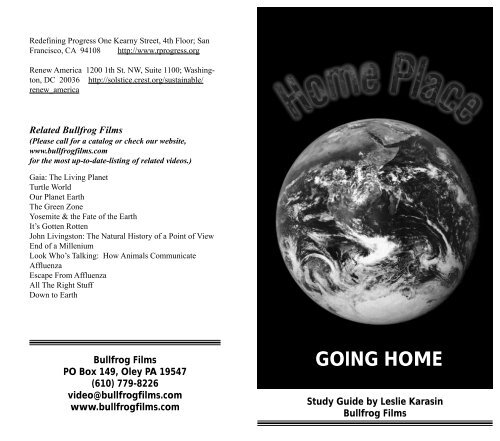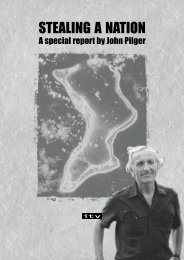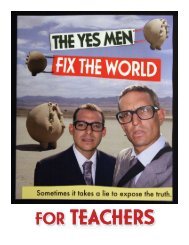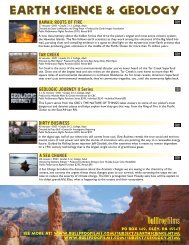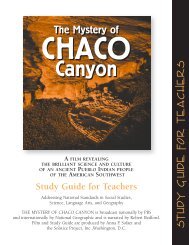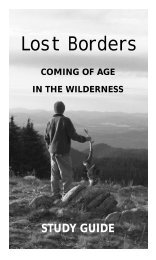Study guide - Bullfrog Films
Study guide - Bullfrog Films
Study guide - Bullfrog Films
- No tags were found...
You also want an ePaper? Increase the reach of your titles
YUMPU automatically turns print PDFs into web optimized ePapers that Google loves.
Redefining Progress One Kearny Street, 4th Floor; SanFrancisco, CA 94108 http://www.rprogress.orgRenew America 1200 1th St. NW, Suite 1100; Washington,DC 20036 http://solstice.crest.org/sustainable/renew_americaRelated <strong>Bullfrog</strong> <strong>Films</strong>(Please call for a catalog or check our website,www.bullfrogfilms.comfor the most up-to-date-listing of related videos.)Gaia: The Living PlanetTurtle WorldOur Planet EarthThe Green ZoneYosemite & the Fate of the EarthIt’s Gotten RottenJohn Livingston: The Natural History of a Point of ViewEnd of a MilleniumLook Who’s Talking: How Animals CommunicateAffluenzaEscape From AffluenzaAll The Right StuffDown to Earth<strong>Bullfrog</strong> <strong>Films</strong>PO Box 149, Oley PA 19547(610) 779-8226video@bullfrogfilms.comwww.bullfrogfilms.comGOING HOME<strong>Study</strong> Guide by Leslie Karasin<strong>Bullfrog</strong> <strong>Films</strong>
The Control of Nature. John McPhee. Farrar StraussGiroux, New York: 1989.Going Home is one of the four videos in the Home Placeseries, which are based on Canadian ecologist J. StanRowe’s book Home Place: Essays on Ecology. Theseries attempts to redefine the role of human beings asone of Earth’s species and look anew at the systems whichsustain and constitute life on the planet. Hosted by J. StanRowe and narrated by Liona Boyd, the series consists ofInside - Outside, Life Cycles, Partnership, and GoingHome. Each film is 26 minutes.Other videos in the series:Inside - OutsideImages of the earth from space finally enabled us todiscard the human-centered concept of environment,replacing it with a more universal idea of ecosystems.Earth itself is conceived of as living...as an ecologicalbeing.Life CyclesExplores the problem of trying to distinguish betweenliving and non-living parts of the Earth. Everything onearth is linked by the cycling of matter and flows ofenergy. Life is a property of Earth.PartnershipExplores the challenges faces by industrial societies asthey shift from their present exploitative relationship withearth ecosystems towards a more sustainable partnership.Shows what happened to ancient societies that livedbeyond their ecological means, and points to models ofpartnership that are possible.© Copyright 1999 <strong>Bullfrog</strong> <strong>Films</strong>, Inc.,This <strong>guide</strong> may be copied for noncommercial classroom use.The Trumpeter Journal of Ecosophy. P.O. Box 5883 Stn.B, Victoria B.C. Canada, V8R 6S8.Western Man and Environmental Ethics. Ian Barbour, ed.Addison-Wesley, Reading, MA: 1973.What Are People For? Wendell Berry. North Point Press,Berkeley: 199028; SanFrancisco, CA 94133Earth Island Institute 300 Broadway, Suite 28;SanFrancisco, CA 94133Institute for Global Futures Research PO Box 263EEarlville QLD 4870 AustraliaInstitute for Local Self-Reliance 2425 18th St. NW;Washington, DC 20009 http://www.ilsr.orgInternational Turn Off Your TV Weekhttp://www.whitedot.org/welikeit.htmlNational Centre for Sustainable Society 1896 WatsonStreet Victoria, BC Canada V8R 6N6 http://www.islandnet.com/~ncfs/ncfsNational Parks and Conservation Association 1015 31stSt., NW, 4th Floor, Washington, DC, 20007.The Land Institute Route 3, Salina, KS, 67401.The Nature Conservancy National Headquarters: 4245 NFairfax Drive, Suite 100, Arlington, VA 22203 http://www.tnc.orgTV Free America http://www.tvfa.org9
Simple in Means, Rich in Ends: Practicing Deep Ecology.Bill Devall. Peregrine Smith, Salt Lake City: 1988.Technology, Environment, and Human Values. IanBarbour. Praeger, New York: 1980.The Arrogance of Humanism. David Ehrenfeld. OxfordUniversity Press, New York: 1978.The Control of Nature. John McPhee. Farrar StraussGiroux, New York: 1989.The Trumpeter Journal of Ecosophy. P.O. Box 5883 Stn.B, Victoria B.C. Canada, V8R 6S8.Western Man and Environmental Ethics. Ian Barbour, ed.Addison-Wesley, Reading, MA: 1973.What Are People For? Wendell Berry. North Point Press,Berkeley: 1990.Organizations and WebsitesCenter for a New American Dream 6930 Carroll Avenue,Suite 900; Takoma Park, MD 20912 http://www.newdream.orgNot Man Apart. Friends of the Earth, 530 Seventh St.SE, Washington, DC, 20003.Simple in Means, Rich in Ends: Practicing Deep Ecology.Bill Devall. Peregrine Smith, Salt Lake City: 1988.Technology, Environment, and Human Values. IanBarbour. Praeger, New York: 1980.The Arrogance of Humanism. David Ehrenfeld. OxfordUniversity Press, New York: 1978.8ContentsSynopsisSynopsis p. 1Key Concepts p. 2Before Viewing p. 4After viewing p. 5Glossary p. 6Resources p. 6Related <strong>Bullfrog</strong> <strong>Films</strong> p. 10The beaver, observed busily preparing a dam,appears to have quite a lot in common with humans. It isfelling trees, actively transforming its environment,working hard to generate favorable conditions. We mightstop our observation there and conclude that we are muchlike at least one other species. But if we look closer, werealize that the beaver is still different from us in manyimportant ways. It does not drive other animals from itsenvironment, nor does it cut down more trees than itneeds. Instead the beaver satisfies its own basic needswhile peacefully tolerating other species and respectingnatural limits.Humans have gotten out of kilter with naturalsystems and natural limits, and we are often intolerant ofother species. The lack of cooperation which we demonstratetowards other species does not come from auniquely human hyper-competitive nature. It derivesfrom the belief that we are different—that we are superior.We are inculcated at a young age into the cultural myththat humans are superior to all other species, sinceuniqueness must imply superiority. Following thisillogical leap, we make others. Since we are superior toother species, clearly natural resources are meant for ouruse, and we need not heed the welfare of others. Thesedangerous conclusions spring from the isolationism wehave adopted toward other natural beings.1
We have isolated ourselves physically as well asintellectually. Most North Americans have little realcontact with nature. We spend most of our time inside,and depend increasingly on technology for insulationfrom natural processes. We light the night so it is nodifferent from the day; we regulate temperatures so thatsummer and winter feel the same; we look to computersand televisions for stimulation. With each technologicaladvance, we lose some of our connections. It is easy tosee how many people are able to ignore the problems thatwe are causing in the ecosphere; most people are so out oftouch with natural systems that they might not notice evendramatic changes.We have become aliens on our own planet,pursuing human growth with no thought to the impacts ofour actions. The promise for a reversal of this trend liesin the opportunity we still have to break out of the culturaland technological isolationism we have generated. Whenwe reconsider our role as earthlings, we will come tounderstand that we are part of ecosystems, and we are asdependent on other species as they are on our sensiblebehavior.Key ConceptsThe film presents some revolutionary and highlyphilosophical ideas, many of which are a challenge toconventional modern thought. To help both studentsand teachers work through the material in the film,some of its key concepts are enumerated below.• Cultural myth. There is a widespread belief, establishedand disseminated through church, state, andeducation, that humans are the most importantspecies on the planet. The implications of this ideafor our behavior towards other species and the planetare monumental: we take full liberty to behave2Connecting with Nature: Creating Moments That LetEarth Teach. Michael J. Cohen. World Peace University,Oregon: 1989.Ecology, Community, and Lifestyle. Arne Naess. CambridgeUniversity Press, New York: 1989.Environmental Science: The Way the World Works.Nebel and Wright. Prentice Hall, NJ: 1993.Healing Gaia: Practical Medicine for the Planet. JamesLovelock. Harmony Books, NY: 1991.How Many People Can the Earth Support? Joel E.Cohen. WW Norton and Co., NY: 1995.“Human Ecology: The Subversive, Conservative Science.”Garrett Hardin. In American Zoologist, Vol 25,1985, pp. 469-476.Human Ecosystems. WB Clapham, Jr. Macmillan, NY:1981.Living in the Environment. G. Tyler Miller, Jr.Wadsworth Company, CA:1992.Making Peace With the Planet. Barry Commoner.Pantheon Books, NY: 1990.Man and the Natural World: A History of the ModernSensibility. Keith Thomas. Pantheon Books, USA: 1983.Monster or Messiah?: The Computer’s Impact on Society.Walter Matthews,ed. University Press of Mississippi,Jackson: 1980.Not Man Apart. Friends of the Earth, 530 Seventh St. SE,Washington, DC, 20003.7
progress consists of understanding our dependenceon ecosystems, rather than having more technologyand wealth. He says that progress will be achievedwhen we look beyond human welfare. How do youfeel about this idea of progress? How can we achieveit? How is it different than conventional notions ofprogress?GlossaryHumanism A belief in the superiority of the humanspecies.Biodiversity, Biological Diversity Diversity of livingthings; includes not only variation of species on Earth,but also variation of ecosystems and genes.Native species A species which normally lives in aparticular ecosystem.Invasive species; Alien species; Non-Native species;Exotic species One which is introduced, whether throughmigration or deliberately or accidentally by humans.These species sometimes do no harm, but may take overand eliminate native species.ResourcesBooks, Articles and JournalsA Bicentennial Malthusian Essay: Conservation, Population,and the Indifference to Limits. John F. Rohe.Rhodes and Easton, Michigan: 1997.recklessly and without regard for others. Wrapped inthis pervasive notion, we do not deal with theharmful impacts of our actions.• Technological isolation. We are removed from ourenvironments and ecosystems by the technologicalcomforts and conveniences of everyday life. As aresult, we rarely experience nature personally andvividly, and we have largely forgotten how to relateto the natural world. This isolation is anotherimportant factor in our lack of respect for oursurroundings.• Aliens on Earth. The cumulative effect of ourcultural and technological isolation is that we do notknow or relate to our planet, while we behave as ifthe Earth is ours for the taking. Consequently, wehave lost touch with natural limits and the balancewhich nature has, over time, established. As long aswe ignore these limits, we have a frightening potentialto do enormous harm.• Breaking down our cocoons. There is hope for ourability to shift away from the isolationism we havecreated, but it hinges on: our recognition, ideologically,of our proper role as earthlings, and an effort tomove away from the comforts of technology, at leastsufficiently to get to know our natural communitiesagain. If we think of ourselves as just one species ofmillions, and we make an effort to experience naturalprocesses, we will be much closer to being in balancewith the planet.A Sand County Almanac. Aldo Leopold. Oxford UniversityPress, NY: 1949.Ashphalt Nation. Jane Holtz Kay. Crown Publishers, NY1997.63
Before ViewingThe following activities are meant to enhanceunderstanding and enjoyment of the film, and can beeffectively performed in a variety of ways.• Take a poll among students of how much time theyspend outdoors each day, on average. The film saysthat the average North American spends 95% of hertime indoors. Since each hour is 4.2% of the day, thismeans that most are indoors for 22.8 hours. Incomparison with time outdoors, how much time dostudents spend watching TV? Using computers orplaying computer games?• Think about where our time outdoors is spent. Howmuch time do we spend in truly “natural” settings?What do we do in these regions? (e.g. If we go to apark or wilderness area, do we fish/hunt/swim/boat/hike/ski/bird-watch/etc?) What do each of theseactivities say about our relationship to nature?• Discuss humans’ role on the planet. What is ourrelationship to other species? We are different fromother species; does this mean that we are better? Dowe have the right to behave very differently fromother animals in terms of our use of natural resources,etc?• List things that are considered vital for a decent life.Make distinctions between needs and luxuries. Howhave our consumption requirements changed in thepast 100 years? Do these changes reflect improvementsor steps backward for society?• As a society, what do we think of as progress?4After viewing• The film says that we’re wrapped in cultural andtechnological cocoons. How can we move awayfrom this situation? What might happen if we don’t?• What’s wrong with humanism? What is the importanceof balance, and of respecting limits?• Think back on the fast-forward car scene in the film.How did you feel about it? What did it seem to sayabout the way we live?• Why do alien species like knapweed threaten nativeecosystems? Think about evolution and the idea ofnatural balance. The host says that knapweed lacks“healthful connections.” Are we, as humans, in asimilar position?• The host at one point says that cocoons are comfortable,but that they do not give life. He says that weare still dependent on the ecosphere, despite ourisolation from it. Is comfortable always good? Canyou think of examples of times when the comforts ofmodern technology have prevented you fromexperiencing something? Trying something?Learning something?• What were the results of your preliminary timesurvey? Ask students to change their time-use habitsfor a week. Set a goal as a class of what the changeswill be, and try to reduce TV and/or computer use forthe week. As an alternative, provide informationabout outdoor events or activities, or take a field tripas a class.• At the end of the film, the host says that we need toredefine the notion of progress. He says that real5


